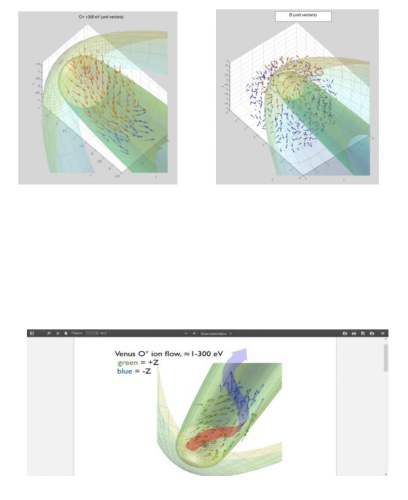Velocity vectors in the Venus wake unrelated to the J x B force
- 1National University of Mexico (UNAM), Institutte of Geophysics, Space Sciences, Ciudad de Mexico, Mexico (hectorperezdetejada@gmail.com)
- 2Swedish Space Research Institute, Kiruna, Sweden
A useful property of the direction of the ion velocity vectors measured across the Venus wake is that they retain a nearly unchanged configuration; that is, the flow orientation maintains an orderly distribution. Evidence to support this view is provided by the flow pattern presented in the top left panel of Figure 1. The average velocity vectors of the planetary O+ ions collected in several orbits of the VEX spacecraft remain well organized along the tail with some of them displaying a common deflection towards the Y axis. That pattern is entirely different from the erratic distribution of the magnetic field vector orientation presented in the top right panel of that figure. The varying direction of the magnetic field vectors differs from the well organized orientation of the velocity vectors which thus is not influenced by changes of the magnetic field direction; namely, their orientation is not dependant on the J x B force. Their direction of motion is subject to a combination of the solar wind aberration force and the Magnus force along the Y-axis as indicated in the top left panel of Figure 1. As a result the direction of the velocity vectors of the planetary ions is not solely controlled by the J x B force. Other forces mostly derived from wave-particle interactions are necessary to justify the organized distribution of the velocity vectors of the streaming flow. The data presented here thus provide an important source of information regarding the orderly direction of the ion velocity vectors along the tail which is unrelated to the J x B force.
A general displacement of the velocity vectors of the solar wind in the Venus wake in the southbound direction is illustrated in the bottom panel of Figure 1. Measurements conducted with the ASPERA instrument show an overall tendency for the flow to shift towards the –Z direction as it has been reported from the data obtained in several VEX orbits (Perez-de-Tejada and Lundin (EPSC-DPS 2019 – 184-1,Vol. 13. 2019),
The tendency of the vortex structure to shift to lower negative Z values with increasing X distances downstream from Venus is more noticeable in orbits approaching maximum conditions of the solar cycle. A comparable difference is also measured in the different width values of the vortex structures becoming smaller during solar cycle maximum conditions.

Figure 1. Average values of the planetary O+ velocity vectors (top left panel) and the magnetic field vectors (top right panel) measured with the VEX spacecraft along the Venus tail. The direction of the velocity vectors exhibits an orderly configuration while the magnetic field vectors become erratic. Red and blue arrows correspond to Z > 0 and Z < 0 locations. (Bottom panel) Schematic view of the corkscrew shape in the distribution of average values of velocity vectors of planetary O+ ions inferred from measurements in several VEX orbits as the ions move downstream from Venus.
How to cite: Pérez-de-Tejada, H. and Lundin, R.: Velocity vectors in the Venus wake unrelated to the J x B force, Europlanet Science Congress 2020, online, 21 September–9 Oct 2020, EPSC2020-63, https://doi.org/10.5194/epsc2020-63, 2020

